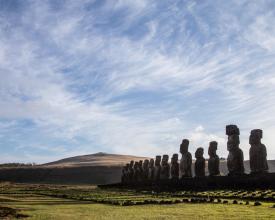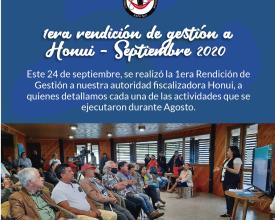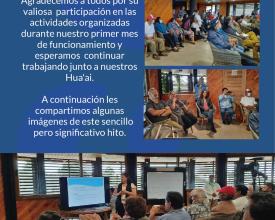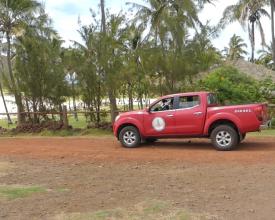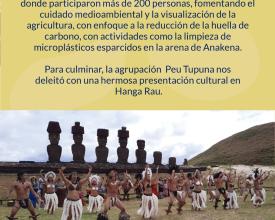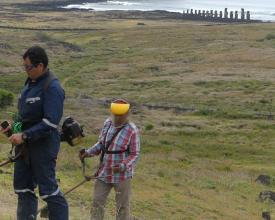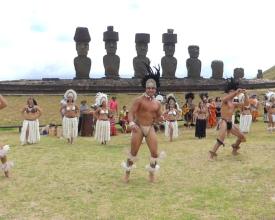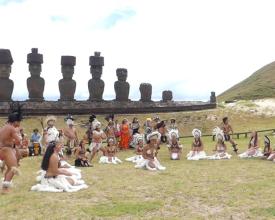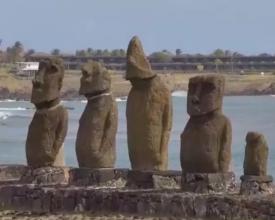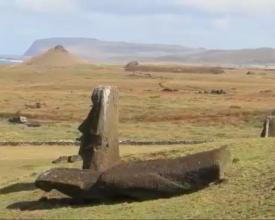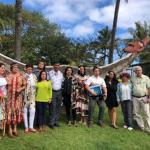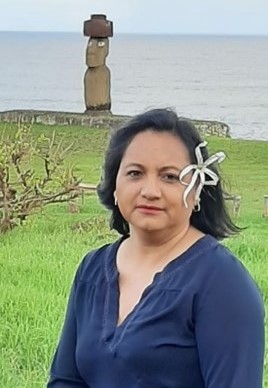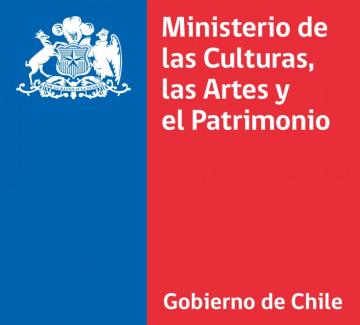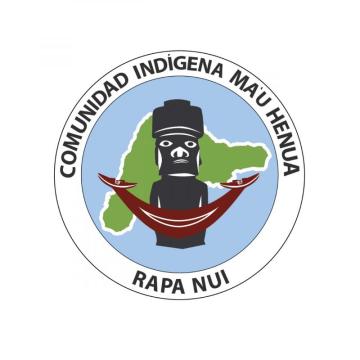
Récupérer l'administration des terres ancestrales : la création de la communauté indigène Ma'u Henua, gardienne du parc national de Rapa Nui, Chili
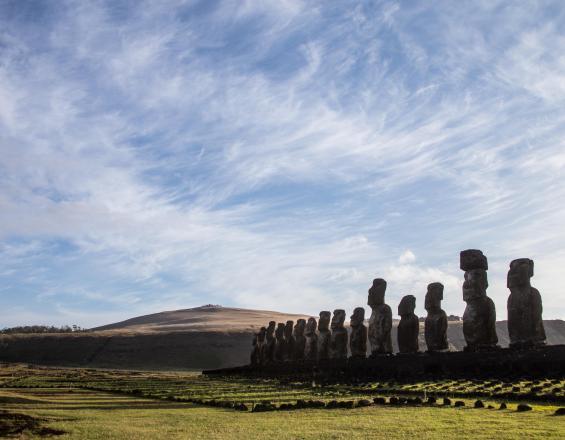
Célèbre pour ses colosses de pierre Moai , l'île de Rapa Nui est entièrement protégée en tant que monument historique, combinant des témoignages archéologiques et les valeurs naturelles d'un écosystème complexe soumis à des risques et vulnérable au changement climatique. Environ 40 % de l'île correspond au parc national de Rapa Nui, inscrit sur la liste du patrimoine mondial depuis 1995 sur la base des critères (i), (iii) et (v). Jusqu'alors, le système réglementaire conçu sur le continent chilien n'avait pas suffisamment pris en compte la fragilité de l'écosystème insulaire, l'importance de son patrimoine archéologique et le caractère unique de l'identité culturelle et du mode de vie du peuple Rapa Nui. Cela a eu un impact négatif sur la conservation et a entraîné une dissociation progressive de la communauté. Pour remédier à cette situation, la communauté Rapa Nui a proposé au gouvernement chilien une gestion communautaire. En 2017, la communauté indigène polynésienne Ma'u Henua s'est vue confier l'administration du parc, assumant ainsi les défis que la gestion interne implique.
Contexte
Défis à relever
La gestion a été affectée par un défi social sous-jacent : la nécessité d'impliquer la communauté dans la protection du patrimoine. L'administration par des institutions extérieures a créé une distance entre la communauté et la protection et l'utilisation de son patrimoine. Cette distanciation a freiné le renforcement des institutions locales et le développement des capacités de la jeunesse locale en matière de gestion du patrimoine. L'absence d'expériences et de rôles dans le système de gestion a limité le développement d'objectifs communs. La dissociation entre la communauté et son patrimoine, ainsi que l'absence de mécanismes participatifs permettant d'impliquer les habitants et d'utiliser leurs connaissances traditionnelles, se sont traduites par la dégradation du patrimoine culturel et naturel de l'île. La gestion interne a nécessité la mise en place de mécanismes de dialogue et d'éducation pour une administration adéquate, en envisageant des protocoles culturellement sûrs pour la protection du patrimoine culturel dans le cadre de la transition de l'administration de l'État à l'administration de la communauté.
Emplacement
Traiter
Résumé du processus
Le transfert nécessitait une base juridique, des ressources humaines qualifiées et des connaissances (BB1 & BB2). Ma'u Henua a impliqué des jeunes ayant fait des études supérieures et possédant une expérience professionnelle, qui cherchaient des opportunités sur l'île. Cela a permis aux jeunes Rapa Nui d'appliquer leurs connaissances et leur expérience, en se connectant aux connaissances traditionnelles et locales impliquant les anciens et les autres habitants (BB2 & BB3). Tout au long du processus, il y a un dialogue constant avec la communauté indigène qui communique ses besoins et apporte son soutien à une gestion appropriée, les locaux étant également impliqués en tant que personnel du parc national. La participation directe de la communauté Rapa Nui est essentielle, car elle favorise le transfert des connaissances, de la langue et des traditions aux nouvelles générations, en reliant notre idiosyncrasie et notre vie à celles de nos ancêtres. Dans ce cadre, un département dédié à l'archéologie (BB4) est fondamental pour améliorer la conservation et surveiller les impacts du changement climatique. La coordination avec d'autres institutions qui peuvent contribuer à la gestion est essentielle.
Blocs de construction
Institutionnalisation de l'administration indigène
Afin de créer un environnement favorable à la mise en place d'une institution autochtone chargée de l'administration du parc national, il a été nécessaire de développer un certain nombre d'instruments juridiques, administratifs et financiers. Ce processus d'institutionnalisation a nécessité l'étude de références et la création d'un cadre réglementaire et représentatif pour les opérations de la nouvelle entité de gestion. Ce cadre est basé sur un dialogue avec les institutions gouvernementales afin de mettre en œuvre le transfert administratif, et l'établissement d'instruments juridiques qui ratifient la nouvelle entité administrative. Les étapes les plus importantes de ce processus ont été les suivantes
- Consultation autochtone en octobre 2015 en accord avec la Convention 169 de l'OIT.
- Création des statuts de la communauté indigène Ma'u Henua établissant sa structure, son fonctionnement, sa composition et ses Honui (représentants des clans).
- Plan opérationnel dans lequel la CONAF et Ma'u Henua gèrent ensemble le parc entre 2016 et 2017.
- Cadre susceptible de réglementer les processus internes d'audit économique et de comptes de gestion publique afin de contribuer à une gestion transparente.
- Promulgation d'un décret du ministère des biens nationaux accordant l'administration du territoire du parc à la communauté indigène.
Facteurs favorables
La loi indigène (loi 19.253, 1993) a créé, selon le concept des communautés indigènes, la Commission pour le développement de l'île de Pâques, où des représentants du peuple Rapa Nui ont dialogué avec des représentants du gouvernement chilien. Cette autorité a permis de faire progresser la volonté politique et de générer la confiance, en obtenant, entre autres, le transfert de l'administration du patrimoine Rapa Nui à la communauté locale.
Leçon apprise
(1) Le conseil d'administration est élu pour une période de 4 ans. Un nouveau conseil a été élu récemment. Le transfert permettra une restructuration basée sur les leçons tirées de la première administration, permettant l'établissement de priorités pour améliorer la gestion, l'implication de la communauté et les protocoles de sécurité du COVID-19.
(2) L'administration dirigée par Ma'u Henua a réalisé des progrès significatifs en matière d'autonomisation locale et de gestion du patrimoine culturel, mais le processus n'a pas été épargné par divers conflits internes et avec le gouvernement chilien, dans le cadre d'une transition.
(3) Le transfert de l'administration de l'État à Ma'u Henua n'a pas été facile, en raison de facteurs politiques, sociaux et culturels. Cependant, des progrès significatifs ont été réalisés dans l'organisation et la gestion du parc national. Ces progrès doivent être analysés en profondeur afin de jeter les bases de nouvelles relations et de propositions de gestion par le nouveau conseil d'administration.
(4) Nécessité d'élaborer un plan de gestion pour le site du patrimoine mondial avec une approche intégrale incluant les points de vue d'autres organisations locales, nationales et internationales.
Renforcement de la capacité interne de la communauté à se constituer en gestionnaire de parc
Afin de se préparer à assumer la responsabilité de la gestion du parc national, la communauté a dû renforcer ses capacités sur les plans juridique, administratif et technique. Cette approche a également pris en compte le renforcement des capacités des gardes forestiers locaux, chargés de transmettre, de promouvoir et de sauvegarder la valeur culturelle de leur patrimoine. Ma'u Henua est devenu un espace où divers domaines de spécialisation technique universitaire et des experts locaux peuvent développer leurs activités de manière complémentaire et conjointe. C'est l'un des espaces les plus importants pour l'application de méthodologies culturelles et techniques qui dialoguent avec le contexte du patrimoine matériel et immatériel.
Facteurs favorables
- Le processus d'institutionnalisation de l'institution indigène a permis aux membres de la communauté de s'impliquer et de se familiariser avec l'administration, en développant de nouvelles compétences et en renforçant leurs connaissances.
- Les jeunes formés sur le continent étaient prêts à s'engager dans la gestion de la zone protégée et à revenir vivre sur l'île.
- Création d'opportunités sur l'île et politiques nationales pour le développement communautaire.
- Accord avec la CONAF et le ministère de la culture et des arts.
- Riches connaissances locales des membres de la communauté Rapa Nui.
Leçon apprise
(1) L'île offre des possibilités de travail dans la gestion du parc, les services touristiques et d'autres activités de surveillance. Ces opportunités permettent aux jeunes de reconnaître et d'apprendre à connaître leur culture et leur patrimoine, de réapprendre à les apprécier et à les protéger. La reconnaissance mondiale de sa valeur favorise la transmission intergénérationnelle.
(2) L'importance d'impliquer les anciens dans la transmission des connaissances aux jeunes. La participation des citoyens est essentielle à la gestion et il existe un potentiel de capitalisation des connaissances locales.
(3) Permettre aux locaux de jouer le rôle de garde-forestier crée des emplois sur l'île, ce qui permet d'utiliser les connaissances de la communauté Rapa Nui pour communiquer les valeurs de l'île et mieux contrôler leur conservation.
(4) Établissement de protocoles culturellement sûrs et d'alliances respectueuses entre le Ma'u Henua et les institutions de l'État pour unifier les critères de protection du patrimoine.
(5) Élaboration et mise en œuvre d'une structure administrative établissant des procédures et des protocoles.
Intégrer la compréhension et les valeurs indigènes de la nature et de la culture dans le système de gestion du patrimoine
Une étape fondamentale pour reprendre la gestion a été de reconnaître la vision du monde indigène du peuple Rapa Nui et sa compréhension de la nature, ainsi que sa relation avec son héritage culturel dans la gestion de la zone protégée. Cela permet de prendre en compte les besoins et les opportunités spécifiques au lieu. Ce processus implique
- La récupération de la langue indigène, pour créer des documents et du matériel pour la gestion du parc national.
- La prise en compte du système d'organisation ancestral basé sur les clans, à travers l'organisation Honui qui participe au processus de prise de décision dans le parc national.
- Une étude des lieux sacrés.
- La récupération éventuelle du nom Rapa Nui pour nommer l'île au lieu de l'île de Pâques(Isla de Pascua).
- La reconnexion avec les connaissances traditionnelles, les festivités et les expressions culturelles des Rapa Nui.
- Le développement d'un plan d'utilisation publique dans lequel les utilisations traditionnelles de la communauté dialoguent avec les utilisations touristiques et patrimoniales.
- La reconnaissance et la promotion de l'utilisation ancestrale des plantes médicinales sur la base de la création de projets et de programmes pour l'amélioration et la récupération de la composante naturelle et de la médecine ancestrale de Rapa Nui.
- Un plan pour le retour des Tupuna (ancêtres) et des éléments culturels qui se trouvent en dehors de l'île.
Facteurs favorables
- Initiative de la communauté Rapa Nui pour récupérer et valoriser sa culture ancestrale.
- Appui des institutions publiques chargées de la protection du patrimoine : le ministère de la culture et des arts et le service national des forêts du Chili (CONAF), ministère de l'agriculture.
Leçon apprise
(1) Importance de l'intégration des conceptions locales et de la langue indigène dans le système éducatif officiel.
(2) Nécessité de changer la vision touristique de l'île et d'inviter les visiteurs à apprendre d'une culture vivante et de son histoire ancestrale, et à faire partie d'une communauté pendant leur séjour, en s'impliquant dans les activités culturelles, et pas seulement à venir voir un Moai.
(3) Nécessité d'aligner la coopération entre les secteurs de la culture et de l'éducation.
(4) Identification de nouvelles zones nécessitant une protection urgente.
(5) Adaptation des statuts de la communauté indigène à notre idiosyncrasie en tant que peuple.
Renforcement du département de l'archéologie et de la conservation dans le parc national
Le parc national compte des éléments archéologiques exceptionnels. Pourtant, il ne compte qu'un seul spécialiste parmi son personnel. Avec environ 20 000 sites archéologiques situés dans les limites du parc, dont 1 000 Moai et 300 Ahu ou structures cérémonielles, en plus des structures d'habitation, de l'art rupestre et des grottes, l'administration actuelle a donné la priorité à la sauvegarde de la composante archéologique, hautement significative pour la communauté vivante. Le renforcement du département spécial pour la recherche et l'étude de la préservation de cet important patrimoine culturel permet le développement de stratégies de conservation spécifiques à ce type de patrimoine, ainsi que la reconnexion de la communauté avec ses biens culturels. La majorité de ces biens sont exposés aux conditions climatiques de l'île, ainsi qu'à la dégradation due à l'utilisation touristique et aux impacts anthropiques et du bétail. Parmi d'autres activités, cette nouvelle unité a développé :
- Le renforcement des capacités et l'acquisition d'outils d'enregistrement numérique pour le diagnostic du patrimoine archéologique.
- Des projets de conservation basés sur un portefeuille de sites en situation d'urgence et une méthodologie qui recueille les connaissances traditionnelles des rapanui en les reliant aux connaissances scientifiques.
- Partenariats et mise en réseau sur les impacts du changement climatique.
Facteurs favorables
- Spécialistes de l'archéologie au sein de la communauté Rapa Nui
- Mise en place d'un soutien technique institutionnel par l'intermédiaire du STP (Secretaría Técnica Rapa Nui, CMN/Secrétariat technique Rapa Nui).
Leçon apprise
(1) Nécessité d'un département spécialisé dans la recherche et la conservation du patrimoine archéologique au sein du parc national.
(2) Nécessité d'articuler et de coordonner le travail avec d'autres institutions qui ont des problèmes d'interférence avec le patrimoine.
Impacts
- Ma'u Henua administre le parc national de Rapa Nui et toutes les décisions sont validées par l'ensemble de la communauté autochtone. Un processus participatif de prise de décision a été mis en œuvre, qui implique toute la communauté, principalement les Honui, autorité ancestrale et coutumière intégrée par des représentants de chaque famille Rapa Nui, qui sont informés en permanence et avec lesquels les actions avec la communauté sont coordonnées.
- Mise en place de 20 nouveaux sites officiels de visite, sur un total de 25 actuellement, montrant des zones de l'île présentant des valeurs naturelles et culturelles, ce qui permet de réduire l'impact du tourisme sur les anciens sentiers.
- Augmentation des revenus du parc national.
- Création de 300 emplois, entre autres, impliquant des locaux en tant que gardes du parc, ce qui permet d'augmenter le nombre de gardes du parc de 15 à 115.
- Mise en œuvre d'une méthodologie de diagnostic et de suivi basée sur des enregistrements par scanner laser dans un certain nombre de sites.
- Développement d'un plan de visite pour la promotion de l'utilisation durable, à la fois traditionnelle et contemporaine, de l'ensemble du parc national, avec la mise à disposition d'équipements et d'infrastructures pour la visite des sites selon des critères de durabilité.
- Plan de gestion incluant non seulement le parc national mais aussi la connaissance d'une culture d'origine polynésienne qui a développé une culture unique au monde, marquée par des événements complexes qui ont transformé leur existence.
Bénéficiaires
La communauté autochtone Rapa Nui, l'État partie du Chili, les touristes
Objectifs de développement durable
Histoire

J'ai eu l'occasion d'être le premier à occuper ce poste, après que nous, Rapa Nui, ayons obtenu l'administration du parc national, 85 ans après sa création. J'ai ainsi pu contribuer à ce processus historique pour l'île, sa communauté et son patrimoine.
En tant que chef du département d'archéologie, j'avais pour mission de mener des actions pour le retour du patrimoine de Rapa Nui détenu en dehors de notre territoire, de gérer des projets de conservation et d'habilitation pour la préservation des sites archéologiques du parc, ainsi que de promouvoir la capacité interne et l'acquisition d'équipements pour l'enregistrement numérique afin que les tâches habituellement coûteuses de diagnostic et de surveillance puissent être effectuées par la communauté.
Mon expérience de vie a été fondamentale pour ce travail, puisque j'ai grandi auprès de Rafael Rapu Haoa, spécialiste local de la conservation et de la restauration, qui connaît bien les moai et les ahu, qui gère et exécute leur restauration et leur sauvetage et dont la vision, les connaissances et le travail sont présents dans Ahu Tongariki, le projet UNESCO-Japon, le village cérémoniel d'Orongo, entre autres. En outre, j'ai suivi une formation académique formelle sur le continent.
Dans le patrimoine de Rapa Nui, le matériel et l'immatériel sont indissociables. Leur sauvegarde doit être abordée de cette manière et cela a été notre première étape en tant que communauté pour dire au monde : nous sommes indigènes, cela fait partie de notre culture et nous sommes des techniciens, en fournissant une bonne proposition pour la gestion du patrimoine basée sur cette perspective holistique.
L'un des grands dilemmes théoriques de ma profession est le conflit entre la science et les connaissances traditionnelles. En étant autochtone et en étudiant la science en même temps, je vois qu'il s'agit de deux perspectives qui se complètent pour expliquer la réalité. C'est très utile pour la conservation, car cela nous permet de reconnaître la partie matérielle du patrimoine et, en même temps, ses racines culturelles dans les personnes et leur identité.
La perspective scientifique nous permet de donner un sens objectif à la tradition orale en la complétant par des données. Il est essentiel d'avoir un point de vue critique et de ne pas se contenter d'absorber et de reproduire. Il est donc fondamental de considérer les deux côtés pour comprendre et gérer le patrimoine de manière adéquate. En tant qu'administrateurs, c'est ce que nous avons essayé de promouvoir en proposant notre approche de la gestion du patrimoine. (Rafael Rapu, archéologue de Rapa Nui)

